|
|
|
| My Favourite Planet > English > Middle East > Turkey > Ephesus > photo gallery |
| Ephesus, Turkey |
Ephesus photo gallery 1 |
 |
 |
25 of 62 |
 |
 |
|
| |
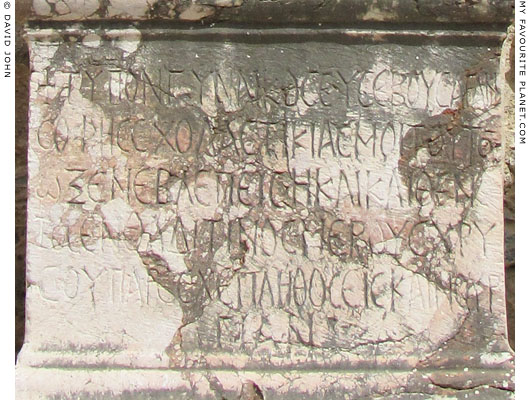
The inscribed pedestal of the statue of Scholastikia, who renovated the "Baths of Scholasikia"
in the late 4th century AD. Her name appears on the second line as CΧΟΛΑCΤΙΚΙΑ. |
| |
"Baths of Scholastikia" or "Baths of Varius"
Part 1
The large bath complex known as the the "Baths of Scholastikia" or "Baths of Varius" is located behind the "Temple of Hadrian" on the north side of Kuretes Street, and is today entered by a stairway up from the street, to the right of the temple (see photos on gallery page 21). There is a second entrance along a narrow alley leading from the "Marble Street", between the Library of Celsus and the Great Theatre. It was discovered by archaeologists in 1926.
Thought to have been built in the first half of the 2nd century AD (possibly around 117-118 AD) by the wealthy Ephesian Publius Quintilius Valens Varius with his wife, who also built the "Temple of Hadrian", the baths were renovated in the late 4th century AD by a Christian woman named Scholastikia, whose statue on an inscribed pedestal still stands at the site (see photo below). Parts from older buildings such as the Prytaneion were used in the renovation.
Covering an area of 13,751 square metres, the three-storey baths were constructed around a large apsidal hall. There was also a library and entertainment rooms, as well as a public latrine and the now infamous brothel, both of which are popular tourist attractions.
Two inscribed statue bases (inscriptions IvE 67 and IvE 3080, now in the Inscriptions Museum, Ephesus), dated 166/167 AD, with almost identical texts honouring Titus Flavius Damianus (Damianus of Ephesus), state that during his term as grammateus of the demos (γραμματεύς, town clerk or secretary) he promised to build and decorate a hall (οἴκος, oikos) in the Baths of Varius. The form and function of the building are not stated and its identity remains unknown, although it has been suggested that it may have been the apsidal hall. [1]
Further photos and information about the baths are currently in preparation. |
| |
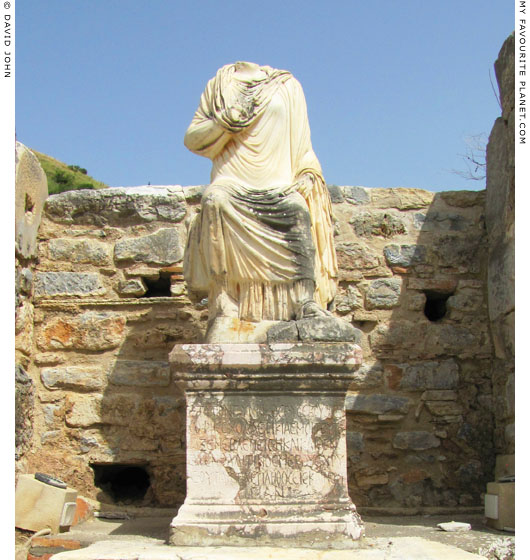
A marble statue of a headless female figure on a base inscribed with
a dedication by Scholastikia, the Christian builder of the baths.
|
The statue and inscribed pedestal were found in 1955 in front of the southern niche of the eastern wall of the baths. [2] It was made in the Roman Imperial period and reused perhaps with the addition of a portrait head of Scholastikia. Her name and the cross at the beginning of the inscription on the pedestal indicate that she was a Christian. The letter Σ (sigma) is written as the Latinized C, typical of the late Antique and Byzantine periods.
☩ τύπον γυναικὸς εὐσεβοῦς <λ>ίαν
σοφῆ ς Σχολαστικίας μοι τοῡ το(ν)
ὧ ξένε, βλέπεις ἥ καί κλιθέν
τος ἐ νθαδί τινος μέρους χρυ-
σοῡ παρέσχε πλῆ θος ἐ ς καινουρ-
γίαν
Inscription Ephesos 3072 (Inschriften von Ephesos (IvE) 453)
at The Packard Humanities Institute. Height of statue 158 cm, height of base 88 cm. |
|
| |
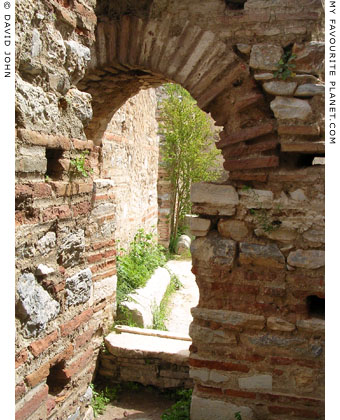
A Roman brick-arched doorway in an alley
at the lower end of Kuretes Street. |
|
|
| |
| |
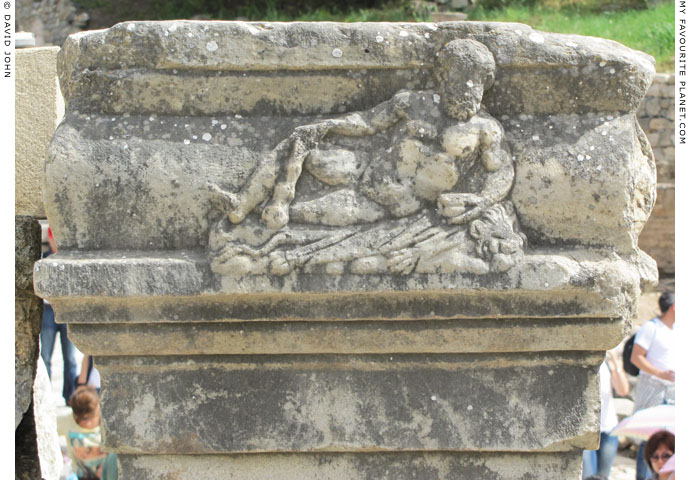
A relief of Herakles reclining on a lionskin, on the side of a pillar, on the corner
of Kuretes Street and Bath Street, near the entrance to the Baths of Scholastikia. |
| |
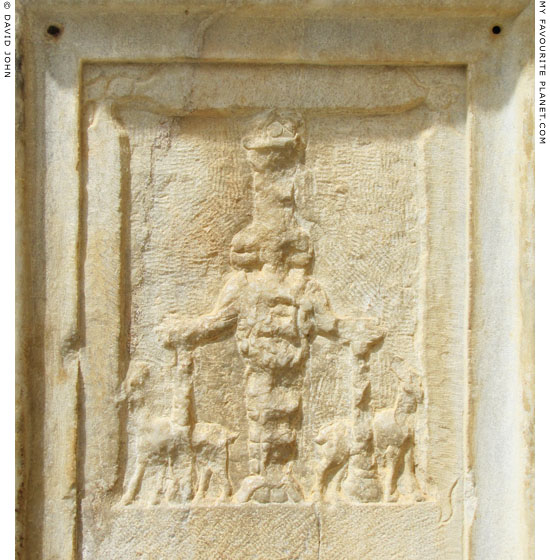
A rough relief of Artemis Ephesia, appearing more like graffiti, on the side
of a pilaster on Bath Street, near the entrance to the Baths of Scholastikia. |
| |
Scholastikia
Baths
or
Varius Baths
Ephesus |
Notes, references and links |
 |
|
1. Damianus of Ephesus and the Varius Baths
See:
Angela Kalinowski, Of stones and stonecutters: reflections on the genesis of two parallel texts from Ephesos (IvE 672 and 3080). In: Gerhard Dobesch et al (editors), Tyche Band 21, 2006, pages 53-72. Holzhausen Verlag, Vienna, 2007.
Angela Kalinowski, Toponyms in IvE 672 and IvE 3080: interpreting collective action in honorific inscriptions from Ephesos. Jahreshefte des Österreichischen Archäologischen Institutes, Band 75, pages 117-132. Verlag der Österreichischen Akademie der Wissenschaften, Vienna, 2006. PDF at austriaca.at.
2. Excavation of the baths and discovery of the statue of Scholastikia
See:
F. Miltner, XXI. Vorläufiger Bericht über die Ausgrabungen in Ephesos. In: Jahreshefte des Österreichischen Archäologischen Institutes Band 43, 1956-58, Beiblatt (supplement), columns 1-64 (particularly columns 1-28). At academia.edu.
F. Miltner, XXII. Vorläufiger Bericht über die Ausgrabungen in Ephesos. In: Jahreshefte des Österreichischen Archäologischen Institutes Band 44, 1959, Beiblatt (supplement), columns 243-314. At academia.edu. |
|
|
Photos, articles and map: © David John,
except where otherwise specified.
Additional photos: © Konstanze Gundudis
All photos and articles are copyright protected.
Images and materials by other authors
have been attributed where applicable.
Please do not use these photos or articles without permission.
If you are interested in using any of the photos for your website,
project or publication, please get in contact.
Higher resolution versions are available on request.
Some of the information and photos in this guide to Ephesus
originally appeared in 2004 on davidjohnberlin.de. |
|
| |
 |
Visit the My Favourite Planet Group on Facebook.
Join the group, write a message or comment,
post photos and videos, start a discussion... |
|
|
| |
|
|
|